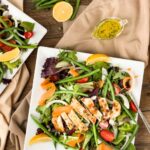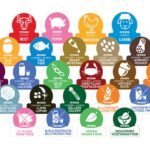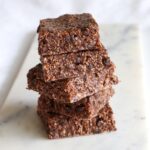Navigating a world of food allergies can feel like a culinary tightrope walk, but mastering the art of allergen-free meal planning empowers you to reclaim control over your diet and your well-being. This comprehensive guide walks you through the process of crafting a delicious and nutritious week’s worth of meals, meticulously avoiding common allergens. We’ll cover everything from planning and recipe adaptation to safe food handling and efficient meal preparation, ensuring that your journey to allergen-free eating is both manageable and enjoyable.
Imagine a week where you effortlessly enjoy varied, satisfying meals, knowing each bite is safe and nourishing. This guide offers detailed recipes, smart shopping strategies, and time-saving techniques, transforming the challenge of allergen-free cooking into a rewarding experience. We’ll explore practical solutions to common pitfalls, offering you confidence in the kitchen and peace of mind at the table.
Planning Allergen-Free Meals
Creating a delicious and nutritious weekly meal plan that avoids common allergens requires careful planning and consideration. This involves selecting recipes, compiling a comprehensive shopping list, and understanding the nutritional breakdown of each meal to ensure a balanced diet. This section details a sample plan, emphasizing variety and nutritional completeness.
A Sample Weekly Allergen-Free Meal Plan
This plan avoids the eight major allergens: milk, eggs, peanuts, tree nuts, soy, wheat, fish, and shellfish. It offers a balanced intake of fruits, vegetables, proteins, and whole grains, crucial for maintaining good health. Remember to adjust portion sizes based on individual caloric needs.
Monday:
Breakfast: Oatmeal made with allergen-free oats, topped with blueberries and a sprinkle of chia seeds. A vibrant bowl of creamy, subtly sweet oatmeal studded with juicy blueberries and tiny, speckled chia seeds. The visual contrast is appealing.
Lunch: Quinoa salad with roasted sweet potatoes, black beans, and a lime vinaigrette. A colorful medley of textures and flavors – fluffy quinoa, tender sweet potatoes, earthy black beans, all brightened by a zesty lime dressing.
Dinner: Chicken stir-fry with brown rice and a variety of colorful vegetables like broccoli, carrots, and bell peppers. A fragrant and vibrant stir-fry, featuring tender chicken pieces nestled amongst crisp-tender vegetables and fluffy brown rice. The colorful array of vegetables makes it visually appealing.
Tuesday:
Breakfast: Scrambled tofu with spinach and tomatoes. A fluffy scramble of subtly savory tofu, punctuated by vibrant green spinach and bright red tomatoes. The textures are varied and interesting.
Lunch: Leftover chicken stir-fry.
Dinner: Lentil soup with a side of gluten-free bread. A hearty and warming soup, rich in lentils and fragrant herbs. The side of crusty gluten-free bread complements the soup perfectly.
Wednesday:
Breakfast: Smoothie made with banana, almond milk (ensure it’s free of other allergens), and spinach. A vibrant green smoothie, creamy and subtly sweet, with a hint of banana sweetness. The vibrant green color is appealing.
Lunch: Leftover lentil soup.
Dinner: Baked salmon with roasted asparagus and quinoa. A beautiful plate, featuring flaky baked salmon, bright green asparagus spears, and fluffy quinoa. The colors are striking and pleasing to the eye.
Thursday:
Breakfast: Allergen-free granola with almond milk. A crunchy and satisfying breakfast, with a mix of textures and a slightly sweet taste. The granola’s golden-brown hue is visually attractive.
Lunch: Salad with grilled chicken or chickpeas and a lemon vinaigrette.
Dinner: Shepherd’s pie with sweet potato topping (using gluten-free flour for thickening if needed). A comforting and visually appealing dish with a rich brown meat filling and a golden-brown sweet potato topping.
Friday:
Breakfast: Fruit salad with coconut yogurt (ensure it’s allergen-free).
Lunch: Leftover Shepherd’s pie.
Dinner: Homemade pizza on a gluten-free crust with dairy-free cheese and various vegetable toppings.
Saturday:
Breakfast: Pancakes made with allergen-free flour blend and topped with fresh fruit.
Lunch: Leftover pizza.
Dinner: Chicken and vegetable skewers with brown rice.
Sunday:
Breakfast: Eggs (if tolerated) with avocado toast on gluten-free bread.
Lunch: Large salad with grilled chicken or fish.
Dinner: Roasted chicken with roasted root vegetables.
Shopping List
Creating a comprehensive shopping list based on the meal plan above is essential for efficient grocery shopping. This list provides estimated quantities; adjust based on family size and preferences.
Produce: Blueberries, spinach, tomatoes, sweet potatoes, broccoli, carrots, bell peppers, asparagus, banana, lemon, avocado, various fruits for fruit salad, root vegetables (e.g., potatoes, carrots, parsnips).
Grains: Allergen-free oats, quinoa, brown rice, gluten-free bread, gluten-free flour blend, gluten-free pizza crust.
Protein: Chicken breasts (approx. 2 lbs), lentils (1 cup dried), salmon fillets (2), tofu (1 block), chickpeas (1 can).
Dairy Alternatives: Almond milk (1 carton), coconut yogurt (1 container), dairy-free cheese.
Other: Chia seeds, lime, olive oil, herbs and spices (to taste), black beans (1 can), allergen-free granola.
Nutritional Information
Providing detailed nutritional information for each meal requires using a nutrition calculator or consulting a registered dietitian. However, this plan emphasizes whole foods, lean proteins, and a variety of fruits and vegetables, ensuring a good source of vitamins and minerals like vitamin A (from sweet potatoes and carrots), vitamin C (from bell peppers and broccoli), iron (from lentils and spinach), and fiber (from whole grains and vegetables). Precise values depend on specific ingredients and portion sizes. For accurate nutritional data, utilize online nutrition calculators and input the specific ingredients and quantities used in each recipe.
Recipe Selection and Adaptation

Creating a week’s worth of delicious and allergen-free meals requires careful recipe selection and, often, adaptation. This involves choosing recipes that naturally exclude common allergens or modifying existing favorites to remove problematic ingredients while maintaining flavor and nutritional value. The following sections detail both approaches, providing examples and guidance for successful allergen-free cooking.
Allergen-Free Recipes: Breakfast, Lunch, and Dinner
This section presents three allergen-free recipes for each meal category. These recipes are designed to be free of the eight major allergens: milk, eggs, peanuts, tree nuts, soy, wheat, fish, and shellfish. Always double-check ingredient labels to ensure products are free from cross-contamination.
Breakfast:
- Coconut Flour Pancakes (Avoids: Milk, Eggs, Wheat, Soy, Peanuts, Tree Nuts, Fish, Shellfish): These fluffy pancakes use coconut flour as a base, providing a naturally gluten-free and grain-free option. Sweetened with maple syrup and featuring a hint of vanilla, they are a delightful and allergen-friendly start to the day. A vibrant golden brown color, they are light and airy in texture.
- Berry Quinoa Breakfast Bowl (Avoids: Milk, Eggs, Peanuts, Tree Nuts, Wheat, Fish, Shellfish): This bowl combines cooked quinoa with a medley of fresh berries, a sprinkle of chia seeds for added nutrition, and a drizzle of honey or maple syrup for sweetness. The vibrant colors of the berries contrast beautifully with the creamy quinoa, creating a visually appealing and healthy breakfast.
- Sweet Potato and Apple Hash (Avoids: Milk, Eggs, Peanuts, Tree Nuts, Soy, Wheat, Fish, Shellfish): This savory hash features roasted sweet potatoes and apples, seasoned with cinnamon and a touch of nutmeg. The earthy tones of the sweet potatoes and the bright red of the apples create a visually appealing contrast. The hash is hearty and satisfying, providing a good source of fiber and vitamins.
Lunch:
- Chicken and Vegetable Stir-fry (Avoids: Milk, Eggs, Peanuts, Tree Nuts, Wheat, Fish, Shellfish): This stir-fry uses a gluten-free tamari or coconut aminos sauce to create a flavorful and savory dish. The vibrant colors of the vegetables—bright green broccoli, orange carrots, and red bell peppers—make it visually appealing. The tender chicken and crisp vegetables create a satisfying textural contrast.
- Lentil Soup (Avoids: Milk, Eggs, Peanuts, Tree Nuts, Wheat, Fish, Shellfish): This hearty soup is packed with protein and fiber, featuring lentils, carrots, celery, and onions in a flavorful broth. The deep orange color of the carrots and the earthy brown of the lentils create a visually comforting appearance. The soup is thick and creamy, yet light and easy to digest.
- Quinoa Salad with Roasted Vegetables (Avoids: Milk, Eggs, Peanuts, Tree Nuts, Wheat, Fish, Shellfish): This salad features fluffy quinoa as a base, tossed with a variety of roasted vegetables such as zucchini, bell peppers, and eggplant. The array of colors from the roasted vegetables makes the salad visually attractive. A lemon vinaigrette adds a bright and tangy flavor.
Dinner:
- Salmon with Roasted Asparagus (Avoids: Milk, Eggs, Peanuts, Tree Nuts, Soy, Wheat, Shellfish): This simple yet elegant dish features pan-seared salmon fillets and tender roasted asparagus. The vibrant green of the asparagus contrasts beautifully with the pink of the salmon. The dish is rich in omega-3 fatty acids and provides a healthy dose of vitamins.
- Chicken and Vegetable Curry (Avoids: Milk, Eggs, Peanuts, Tree Nuts, Wheat, Fish, Shellfish): This fragrant curry uses coconut milk (ensure it’s free of added dairy) as a base, creating a creamy and flavorful sauce. The rich yellow of the curry contrasts with the green of the vegetables and the white of the chicken. The spices provide a warming and comforting aroma.
- Shepherd’s Pie with Sweet Potato Topping (Avoids: Milk, Eggs, Peanuts, Tree Nuts, Soy, Wheat, Fish, Shellfish): This hearty dish uses a lentil or mushroom-based filling instead of ground beef, topped with a creamy sweet potato mash. The earthy tones of the filling and the rich orange of the sweet potato topping create a visually appealing dish. The dish is both comforting and nutritious.
Adapting Existing Recipes
Adapting existing recipes to be allergen-free requires careful substitution of ingredients. The following examples illustrate how to modify popular recipes while maintaining their essence.
Original Recipe: Classic Chocolate Chip Cookies (containing wheat, dairy, and eggs)
Allergen-Free Adaptation: Substitute almond flour for wheat flour, use applesauce or mashed banana in place of eggs, and use dairy-free chocolate chips and a dairy-free butter alternative. The resulting cookies will have a slightly different texture but will retain the characteristic chocolate chip cookie flavor.
Original Recipe: Creamy Tomato Soup (containing dairy)
Allergen-Free Adaptation: Replace the cream with full-fat coconut milk for a creamy texture and similar richness. The coconut milk adds a subtle sweetness that complements the tomato flavor. This substitution maintains the creamy texture and rich flavor of the original soup without the dairy.
Original Recipe: Pasta Carbonara (containing eggs and dairy)
Allergen-Free Adaptation: Replace the traditional cream and egg sauce with a dairy-free cream sauce made from cashew cream or full-fat coconut milk. Use nutritional yeast for a cheesy flavor. The resulting dish will maintain a creamy texture, though the taste will be slightly different.
Nutritional Comparison: Original vs. Allergen-Free Adaptations
Nutritional values will vary depending on the specific ingredients used in both the original and adapted recipes. However, general comparisons can be made. For example, substituting refined wheat flour with almond flour generally increases the fiber content and healthy fats but may slightly reduce carbohydrate content. Replacing dairy cream with coconut milk might increase the fat content, particularly saturated fat, while decreasing the calcium content. Careful ingredient selection and mindful substitutions are crucial to maintaining a balanced nutritional profile in allergen-free adaptations. Always consult a nutritionist for personalized dietary advice.
Meal Preparation and Time Management
Efficiently preparing a week’s worth of allergen-free meals requires careful planning and strategic time management. The key is to minimize time spent cooking during the week by maximizing preparation and batch cooking on one or two designated days. This approach not only saves time but also reduces stress and ensures consistent access to healthy, allergen-free meals.
This section details effective strategies for scheduling meal preparation, employing efficient meal prepping techniques, and implementing a reliable food labeling and dating system. By incorporating these strategies, you can transform the potentially daunting task of allergen-free meal planning into a manageable and even enjoyable process.
Weekly Meal Preparation Schedule
A well-structured schedule is paramount. Consider your busiest days and allocate larger cooking blocks to those days with less demanding schedules. For example, if weekends are your less busy days, dedicate Saturday morning to batch cooking and Sunday evening to preparing components for quick weekday meals. This schedule should include time for grocery shopping, food preparation, cooking, and packaging. A sample schedule might involve spending two to three hours on Saturday prepping ingredients and cooking larger portions of grains, proteins, and vegetables. Then, on Sunday evening, assemble individual meal components, such as chopping vegetables for stir-fries or portioning out pre-cooked grains. This minimizes weekday cooking to simple assembly or reheating.
Meal Prepping and Storage Strategies
Effective meal prepping significantly reduces weekday cooking time. The following strategies streamline the process:
- Batch Cooking: Prepare large quantities of grains (like quinoa or rice), proteins (chicken breast, tofu, or beans), and roasted vegetables. These can be incorporated into various meals throughout the week.
- Ingredient Prepping: Chop vegetables, measure spices, and portion out ingredients in advance. This eliminates time-consuming tasks during the week.
- Make-Ahead Components: Create components like sauces, dressings, or marinades in advance. Store them separately and combine them with other ingredients as needed.
- Freezing for Future Use: Freeze individual meal portions or larger batches of cooked ingredients for later use. Label clearly with contents and date.
- Utilizing Leftovers: Purposefully plan for leftovers. Designate one or two meals each week that use leftover ingredients from previous meals, reducing cooking time and food waste.
Meal Labeling and Dating System
Clear labeling and dating are essential for maintaining food freshness and minimizing waste. A simple and effective system involves using clear, waterproof labels and a permanent marker. Include the following information on each container:
- Meal Name: A brief description of the meal (e.g., “Chicken Stir-Fry,” “Lentil Soup”).
- Date Prepared: The date the meal was cooked or assembled.
- Date to Consume: A recommended date for consumption to ensure optimal freshness (consider the type of food and storage method).
- Allergen Information: A clear statement confirming that the meal is free of specific allergens.
Consider using a color-coded system for different meal types or dietary restrictions for easier identification at a glance. For example, use blue labels for breakfast, green for lunch, and red for dinner. This visual cue helps with quick meal selection during the week.
Building a week’s worth of allergen-free meals is an investment in your health and well-being, a testament to your commitment to mindful eating. By following the strategies Artikeld in this guide – from meticulous planning and recipe adaptation to mindful storage and efficient preparation – you’ll not only create a delicious and safe menu but also cultivate a sustainable approach to allergen-free cooking. Embrace the journey, savor the results, and enjoy the freedom of knowing exactly what you’re eating.
Expert Answers
What if I have multiple allergies?
This guide provides a framework adaptable to multiple allergies. Carefully check all ingredient labels and prioritize recipes that explicitly avoid your specific allergens.
How can I ensure complete cross-contamination prevention?
Use separate cutting boards, utensils, and cookware for allergen-free meals. Thoroughly clean all surfaces before and after preparation. Consider designating specific cooking times for allergen-free items.
What are some good resources for finding allergen-free ingredients?
Specialty grocery stores, online retailers, and even some local farmers’ markets offer a wide selection of allergen-free products. Always carefully read labels to confirm the absence of your specific allergens.
How do I manage leftovers effectively?
Properly label and date all containers, indicating contents and preparation date. Store leftovers in airtight containers in the refrigerator or freezer according to their specific guidelines.


